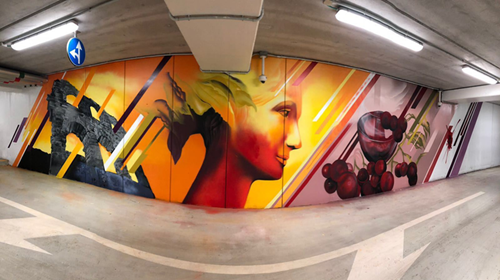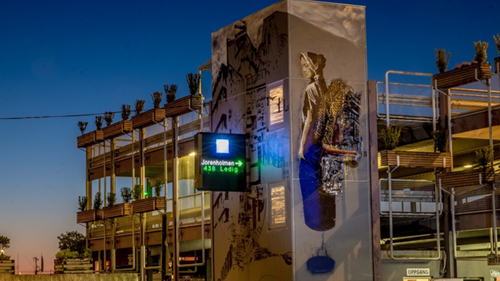
As humans, we classify spaces largely into two categories: those that inspire us -- that emotionally fulfill us -- and meet a practical need, and in contrast, those that are simply functional, that serve a purpose.
Often, parking garages fall into the second category. They meet a real and tangible need but do not emotionally appeal to visitors, encourage patronage or create any real connection. They are bare and blank and barely worthy of attention.
But as locations we must all pass through in order to reach destinations that fulfill our wider needs, why can’t parking garages be more?
Why can’t parking garages be the experience? Why can’t they become places that are talked about in viral social conversations, recommended in peer reviews, promoted in media and compensated accordingly?
.png)
Public Art: Culture That Builds Revenue
As our cities have grown and our need to fit more people into less space has increased at a rapid rate, our tendency towards the ornate architecture and detailed decor of the past has declined.
While we prize our beautifully-designed historic buildings and monuments, we now often find ourselves standing amidst the towers of modern concrete jungles.
Though the art of architecture seems to have changed as modernity and practicality have taken over, our need for artistry in our surroundings has resurfaced over recent years, with the drive for the beautification of cities perhaps stronger now than ever.
Major cities around the world are embarking on projects of renewal.
These projects take the blank canvases within cities -- the sides of buildings, towering walls, empty lots and parking garages -- and transform them from places people pass without notice, to attractions and spectacles in their own right.
Art-based renewal projects are driven not only by aesthetics but also by profit, as more cities and businesses understand the simple equation that culture equals revenue.
Increased visitor numbers seen in prominent street art areas, like those in various parts of Australia, South Africa and South America; improved business investment as seen in Lodz, Poland; revitalised and in-demand suburbs in the USA, and the hundreds-of-thousands of social media posts dedicated to such creations, convey the sheer and palpable opportunity for revenue presented by street art.
It's clear 'renewal', or more specifically, the introduction of art to previously blank city areas, can drive interest, awareness, and perhaps most importantly, profit.
Free coverage of Banksy street art pieces -- uncommissioned and unpaid -- is as prolific as that for any modern artist and acts as a drawcard for locals, tourists, other artists and the politically-minded alike.
Cities like New York in the USA, have capitalized on the momentum of street art to not only improve the reputation of areas and drive tourism but to enhance the value of local real estate.
In areas of the city like Bushwick, real estate agents have worked with local artists, advocating for several new street art pieces, based on its positive impact on culture and in turn, property asking prices.
The examples are as diverse as they are numerous.
And as street art changes the tone and atmosphere of a location, making it less intimidating -- more vibrant and inviting -- more businesses pop up, residents move in and visitors stop by.
More people equates to a greater demand for convenient parking.
By supporting investment in nearby art or cultural installations, or more conveniently, by adopting art and becoming an installation in its own right, a parking garage stands to vastly increase word-of-mouth, peer recommendation, media coverage, and importantly, increase patronage that produces greater revenue.
Parking Garages: Introducing Modern Street Art Museums
As a direct result of the 'purely functional' categorization of parking garages, though often clean and tidy, few resemble more than post-apocalyptic shells of buildings that are seen as dark and dangerous places.
Sparse concrete walls adjoin never-ending concrete floors and purposefully-placed concrete pillars hold everything together so a visitor at least has a sense of safety derived from the observable structural integrity.
But as cities launch these projects of renewal in an attempt to improve safety, tourism, culture, and revenue; parking garages -- locations that meet a need and can't be avoided like dark streets or dingy neighborhoods -- should be first on the list of priorities for beautification.
EasyPark is invested in improving the experience of parking -- not just finding parks and paying for parking, but feeling safe in parking garages, and dare we say it, enjoying them!
Embarking on our own journey of beautification, we are leaving the broad walls of towering city buildings to local governments, and taking the blank canvases that are parking garages into our own hands... or rather, entrusting them to the skilled hands of talented local artists.
Joining forces with garage owners -- at no cost to them -- we are working to help breathe life and culture into these often dark, quiet locations through unique works of art.
And as garage owners have started to see the cultural and revenue-based benefits associated with their support of these projects, one commissioned work, has turned into ongoing partnerships and plans for future installations.
Hand-in-hand with artists who are not only informed by our careful surveys of local stories, issues, and history but also their own experiences, we are transforming the perception of parking garages around the world, one-at-a-time.
Our most recent project in Verona, Italy, has turned a local parking garage into an attraction that captures the attention and admiration of unsuspecting visitors who simply enter in search of a parking space.

"Today, thanks to the cooperation between AMT and EasyPark, we can offer to the 'Parcheggio Centro' users, a work of art that tells about the history and local food products of our city. Our intention is to continue this great partnership, to make the city smarter and closer to citizen's needs," says Francesco Barini, President of AMT Verona.
Similarly, in Stavanger, Norway, what was a bland and boring parking garage wall, is now a striking and stunning expression of culture and a vivid representation of a local issue.

Parking Art creates a rare opportunity for garages and municipalities to talk with the community about their spaces in a positive way, building awareness about garages and local parking options.
EasyPark manages the artistic process from start-to-finish at no cost to the garage owner, as part of our commitment to supporting our clients and the community.
Talk to EasyPark today about starting your unique parking garage art project -- you have nothing to lose, and everything to gain!
About EasyPark Group .png)
Our award-winning digital services have been helping drivers to manage their parking since 2001. But what we do doesn’t stop there. In 900 cities across 15 countries, our technology helps businesses, operators, and cities with parking administration, planning and management. What we actually do is make urban life easier – one parking spot at a time. Visit www.easyparkgroup.com to learn more!



